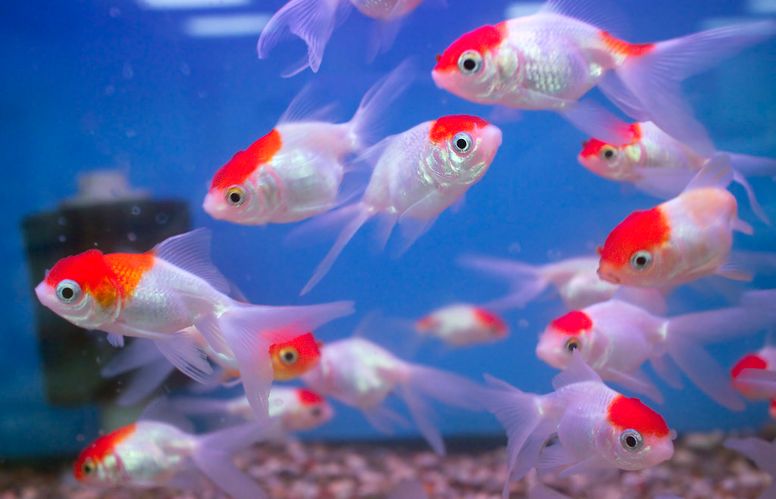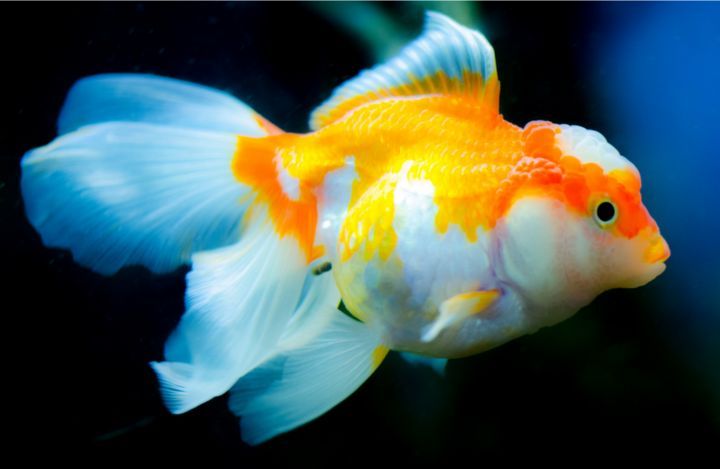There are so many kinds of goldfish: Telescope Goldfish, Comet Goldfish, Shubunkins, etc. It’s hard to keep track of them all! So, how do you tell the Oranda Goldfish apart? What makes them special and unique? Should you add them to your goldfish tank, or should you choose a different kind of goldfish?
Orandas are a type of goldfish with big head. If this intrigues you, keep reading. You’ll learn all about these beautiful, big-headed fish.
What Are Oranda Goldfish?

Oranda Goldfish belong to the family Cyprinidae, and they originate from China. They are a type of fancy goldfish because they were selectively bred to look like the Chinese Lion Dog.
The Chinese Lion Dog is an important symbol in Chinese culture. It appears in art, jewelry, and furniture. It even serves as the protector or guardian of temples.
Goldfish are also highly revered in Chinese culture, so it makes sense to combine the two. Like all goldfish, Orandas are descendants of wild carp. But, they were selectively bred for their looks. Because of this, Oranda Goldfish are only bred in captivity and do not live in the wild.
Why Does My Goldfish Have A Big Head?
Your Oranda Goldfish has such a large head because it was bred that way. Although we don’t know for sure, there’s one likely reason that Orandas ended up as a big head goldfish: it mimics a lion’s mane.
You will notice a large orange cap at the top of your Oranda’s head. This cap is sometimes referred to as the “wen”, and it consists of many outgrowths.
The outgrowths on the head are not present at birth, but begin appearing around 4-5 months of age. These growths will be fully formed at about 1-2 years of age, but they may continue growing for up to 3 years.
What Does The Rest Of Their Body Look Like?
As a type of fancy goldfish, Orandas have large, egg-shaped bodies. Their scales are large and round, and they may have a matte or even metallic finish.
Their tails are usually longer than their bodies, and it’s split to form a fan-like shape.
Most Oranda Goldfish have that trademark yellowish-orange body. But, there are other varieties as well like the Black, Blue, or Red Cap Oranda Goldfish.
The Black Oranda’s body is completely black, including the cap on its head.
Blue Orandas may be light blue, dark blue, or any shade between.
The Red Cap Oranda is the most popular because of its contrasting colors. The body is solid white except for the bright red cap.
How Big Can An Oranda Goldfish Get?
Unlike popular belief, goldfish can grow to be quite large, and Orandas are no exception. On average, Oranda goldfish grow to be about 6-7 in (15.2-17.8 cm). Yet, in well-maintained habitats, these goldfish have grown up to twice that size.
The majority of their body length comes from their tail which can make up ⅔ of their body.
How Long Do Oranda Goldfish Live?
When cared for properly, Orandas will usually live for about 10-15 years. Still, many of these goldfish have lived for over 20 years.
What Care Requirements Do Oranda Goldfish Need

Orandas are one of the easiest goldfish to care for, but they still have certain requirements.
What Size Tank Does An Oranda Goldfish Need?
The tank size is arguably the most important thing to keep in mind when caring for your Oranda. Many people believe their goldfish can live in a bowl or a small tank. Unfortunately, this isn’t true, and the goldfish suffers because of it.
As a baby, the absolute smallest size tank you should house your Oranda in is 10-gallons. This isn’t suitable for their entire life, though, and you should upgrade the aquarium as your fish grows.
For an adult goldfish, the smallest size tank you should have is a 30-gallon. Yet, I recommend having at least 40 or 50-gallons to keep your goldfish happy.
For each additional goldfish you want to house in your tank, you should add an extra 10-gallons.
Goldfish of all kinds grow quite big, and they produce a lot of waste, so they need a huge aquarium.
What many people don’t understand is that a too-small tank will stunt their goldfish’s growth. The body of your goldfish will stop growing when kept in a small aquarium. This will stunt its growth and keep it small.
Some researchers believe that a goldfish’s organs will continue to grow. Nobody is sure if this is true or not, as we haven’t done enough research on the topic.
What we do know is that stunted growth leaves the goldfish with a shorter lifespan. Most kept in a small tank will die within 3 years.
What Water Parameters Do Oranda Goldfish Need?
Goldfish are adaptable, but they are cold-water fish that have their own preferences. Below, we’ve included a guide on how to keep your tank:
- Ammonia: 0ppm
- Nitrites: 0ppm
- Nitrates: <40ppm
- pH: 6.0-8.0
Do Oranda Goldfish Need A Heater?
Fancy goldfish — like the Oranda — can live in temperatures as low as 40° F (4.4° C). Yet, their optimal temperature is 65-72° F (18°- 22° C).
Goldfish can survive in warmer, tropical temperatures, but it’s not recommended. They’re not going to thrive or be happy in very warm or cold temperatures.
Also, make sure that the water temperature stays relatively stable. A drastic increase or decrease in temperature can cause your goldfish to go into shock and die.
What Kind Of Filtration Does An Oranda Goldfish Need?
Likely the hardest part of owning Orandas is keeping their tanks clean. If you’ve had goldfish before, then you know that they produce a lot of waste. It can be difficult keeping up with the water changes needed to keep their aquariums clean.
Usually, you will buy a filter that matches the size of your tank, and that makes sense. In other words, if you have a 50-gallon aquarium, you’ll buy a 50-gallon filter.
We have a different recommendation when it comes to goldfish, though.
Because they produce so much waste, it’s helpful to get a filter that is larger than your tank size. For best results, double the size of your needed filter. If your tank is 50-gallons, get a 100-gallon filter.
When you pick out a filter, be sure to get one with low to moderate flow. Orandas are slow, awkward swimmers, and they don’t do well with a lot of current.
Can You Provide Decorations For This Big Head Goldfish?
Oranda Goldfish are active little fish that like to swim around their tank all day. They enjoy having decorations to explore and hide inside. Decorations will provide enrichment for your Oranda as well as make your tank look nicer.
Thinking about housing your Oranda with a large-eyed goldfish? Be careful about what decorations you choose.
Goldfish with giant eyes — like the Telescope Goldfish — have bad eyesight. They’re also prone to damaging their eyes and getting eye infections. If you keep them as tankmates to your Orandas, limit the number of decorations in the tank.
Plants
Whether you choose to keep plants in your tank depends on you. Are you okay with your goldfish eating those plants over time? Goldfish love greens and need veggies to stay healthy.
We definitely recommend keeping live plants in your tank. It’s a good way to spruce up your tank while providing your goldfish with a source of greens.
Try to stick with plants that have thicker leaves rather than plants that are flowy. This is because flowing leaves can make it harder for goldfish to swim. Fancy goldfish like Orandas already have a harder time swimming. They don’t need anything getting in their way.
What Food Do Oranda Goldfish Eat?
Oranda Goldfish are opportunistic omnivores. They will eat just about anything they can fit in their mouth. This includes small fish and crustaceans. So, you must be careful about which tank mates you choose to keep with your goldfish.
You should feed your Oranda a regular diet of flake or pellet goldfish food.
You should also give them a regular diet of nutritious leafy greens.
If you don’t mind spending the extra money, you can provide them with aquatic plants which they will eat over time. For a cheaper option, you can feed them pieces of spinach, kale, or other leafy greens.
Because Orandas are omnivores, you should provide them with a varied diet. This includes live food. Still, you should give live food sparingly, as a snack. Some high-protein foods to give your fish include bloodworms, brine shrimp, and daphnia.
Like many fish, your Orandas will continue to eat throughout the day, even when they’re not hungry. To avoid overfeeding them, you should feed adults once a day, and juveniles twice a day.
What Are Good Oranda Goldfish Tank Mates?

Oranda Goldfish are slow-moving fish with peaceful temperaments. They are very active, constantly swimming around their tank.
They are also social and friendly and enjoy interacting with their human caretakers. It’s important to keep this in mind when selecting tankmates, or your goldfish’s quality of life may suffer.
Generally, it’s best to keep Oranda Goldfish with other species of goldfish. The care requirements of goldfish are different than that of most fish sold in stores.
Most coldwater species that you can buy in a pet store aren’t going to be suitable for goldfish. They’re likely going to be too aggressive and outcompete your goldfish for food. Or, they’ll be too small and will become a meal themselves.
Although Oranda Goldfish are peaceful, they are opportunistic omnivores. If you house them with a fish species that is small enough to fit in their mouth, then they will become food.
If you want to get tankmates that aren’t goldfish, they should meet a few criteria. They should be coldwater, bigger than your goldfish’s mouth, and peaceful.
Do Oranda Goldfish Like To Be Touched?
Goldfish in general don’t like when you touch them. It can be distressing for them the same as tapping on their glass tank or shining a light in their eye. Luckily, it’s not usually necessary to handle your goldfish, so just don’t do it.
Are Oranda Goldfish Good For Beginners?
Goldfish in general aren’t the greatest for beginners. This is because of the amount of waste they produce. You have to keep up on water changes and watch the water parameters. Not to mention, most beginners don’t want such a large aquarium cluttering up their home.
When it comes to difficulty, Orandas are somewhere in the middle. They have no real health problems like the Telescope Goldfish. Still, they are more sensitive to water quality. Some kinds of goldfish are very hardy, but the Oranda isn’t one of them. You’ll need to watch your water quality to make sure there aren’t any dangerous, rapid changes.
The Oranda’s large cap does not usually pose any problems, but there are always exceptions. Occasionally, an Oranda may have a cap that grows too large. If this happens, they may have trouble seeing and eating.
Conclusion
Oranda Goldfish are a type of fancy goldfish with wide, unique heads. They’re peaceful, beautifully patterned fish that can add color to any tank.
Thinking about adding an Oranda to your goldfish tank? They might be a great addition if you want an easy, bright, unique critter.

